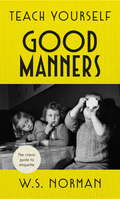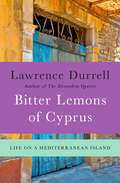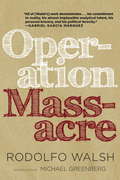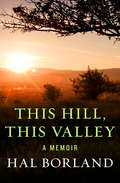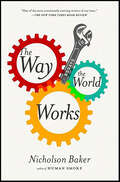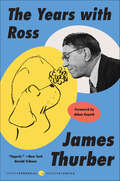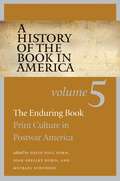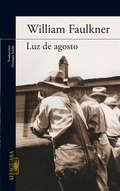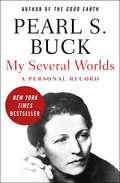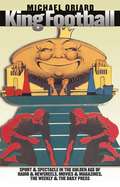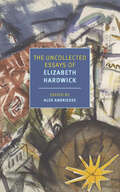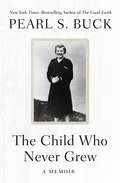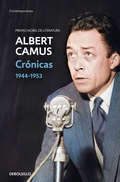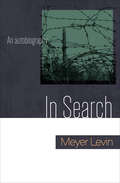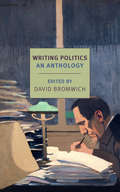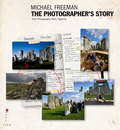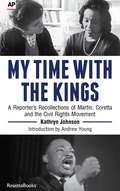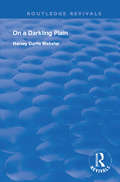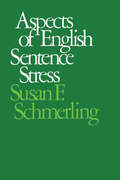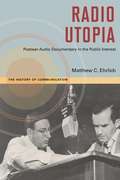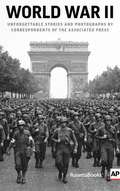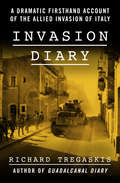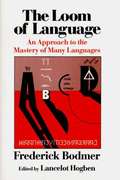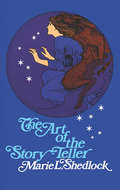- Table View
- List View
Teach Yourself Good Manners: The classic guide to etiquette
by W S NormanOriginally published in 1958, Teach Yourself Good Manners is a fascinating guide, packed full of both timeless advice and tips that demonstrate just how much life has changed in the 60 years since it published. Indeed, the author, W S Norman, would doubtless be horrified by modern manners and would implore us to study his rather uptight but very funny rules for modern living. Amusing, intriguing and sometimes rather inspiring, this handbook is a window into how life would have looked had we lived in a 'a simpler age' - in which, confusingly, they had rather a lot of strange rules.Since 1938, millions of people have learned to do the things they love with Teach Yourself. Welcome to the how-to guides that changed the modern world.
Bitter Lemons of Cyprus: Life on a Mediterranean Island
by Lawrence DurrellFrom the New York Times–bestselling author of the Alexandria Quartet: &“A superlative piece of . . . writing . . . rooted in the Mediterranean scene&” (Time). In 1953, as the British Empire relaxes its grip upon the world, the island of Cyprus bucks for independence. Some cry for union with Athens, others for an arrangement that would split the island down the middle, giving half to the Greeks and the rest to the Turks. For centuries, the battle for the Mediterranean has been fought on this tiny spit of land, and now Cyprus threatens to rip itself in half. Into this escalating conflict steps Lawrence Durrell—poet, novelist, and a former British government official. After years serving the Crown in the Balkans, he yearns for a return to the island lifestyle of his youth. With humor, grace, and passable Greek, Durrell buys a house, secures a job, and settles in for quiet living, happy to put up his feet until the natives begin to consider wringing his neck. More than a travel memoir, this is an elegant picture of island life in a changing world.
Operation Massacre
by Michael Greenberg Rodolfo Walsh Daniella Gitlin Ricardo Piglia1956. Argentina has just lost its charismatic president Juán Perón in a military coup, and terror reigns across the land. June 1956: eighteen people are reported dead in a failed Peronist uprising. December 1956: sometime journalist, crime fiction writer, studiedly unpoliticized chess aficionado Rodolfo Walsh learns by chance that one of the executed civilians from a separate, secret execution in June, is alive. He hears that there may be more than one survivor and believes this unbelievable story on the spot. And right there, the monumental classic Operation Massacre is born.Walsh made it his mission to find not only the survivors but widows, orphans, political refugees, fugitives, alleged informers, and anonymous heroes, in order to determine what happened that night, sending him on a journey that took over the rest of his life.Originally published in 1957, Operation Massacre thoroughly and breathlessly recounts the night of the execution and its fallout.From the Trade Paperback edition.nformers, and anonymous heroes, in order to determine what happened that night, sending him on a journey that took over the rest of his life.Originally published in 1957, Operation Massacre thoroughly and breathlessly recounts the night of the execution and its fallout.
This Hill, This Valley: A Memoir
by Hal BorlandA memoir of a year immersed in nature on a New England farm, by the national bestselling author of The Dog Who Came to Stay. After a nearly fatal bout of appendicitis, Hal Borland decided to leave the city behind and move with his wife to a farmhouse in rural Connecticut. Their new home on one hundred acres inspired Borland to return to nature. In this masterpiece of American nature writing, he describes such wonders as the peace of a sky full of stars, the breathless beauty of blossoming plants, the way rain swishes as it hits a river, and the invigorating renewal brought by the changing seasons. The delights of nature as Borland observes them seem boundless, and his sense of awe is contagious.
The Way the World Works: Essays
by Nicholson BakerNicholson Baker, who “writes like no one else in America” (Newsweek), here assembles his best short pieces from the last fifteen years. The Way the World Works, Baker’s second nonfiction collection, ranges over the map of life to examine what troubles us, what eases our pain, and what brings us joy. Baker moves from political controversy to the intimacy of his own life, from forgotten heroes of pacifism to airplane wings, telephones, paper mills, David Remnick, Joseph Pulitzer, the OED, and the manufacture of the Venetian gondola. He writes about kite string and about the moment he met his wife, and he surveys our fascination with video games while attempting to beat his teenage son at Modern Warfare 2. In a celebrated essay on Wikipedia, Baker describes his efforts to stem the tide of encyclopedic deletionism; in another, he charts the rise of e-readers; in a third he chronicles his Freedom of Information lawsuit against the San Francisco Public Library. Through all these pieces, many written for The New Yorker, Harper’s, and The American Scholar, Baker shines the light of an inexpugnable curiosity. The Way the World Works is a keen-minded, generous-spirited compendium by a modern American master.
The Years with Ross
by James ThurberFrom iconic American humorist James Thurber, a celebrated and poignant memoir about his years at The New Yorker with the magazine’s unforgettable founder and longtime editor, Harold Ross“Extremely entertaining. . . . life at The New Yorker emerges as a lovely sort of pageant of lunacy, of practical jokes, of feuds and foibles. It is an affectionate picture of scamps playing their games around a man who, for all his brusqueness, loved them, took care of them, pampered and scolded them like an irascible mother hen.” —New York TimesWith a foreword by Adam Gopnik and illustrations by James ThurberAt the helm of America’s most influential literary magazine from 1925 to 1951, Harold Ross introduced the country to a host of exciting talent, including Robert Benchley, Alexander Woollcott, Ogden Nash, Peter Arno, Charles Addams, and Dorothy Parker. But no one could have written about this irascible, eccentric genius more affectionately or more critically than James Thurber, whose portrait of Ross captures not only a complex literary giant but a historic friendship and a glorious era as well. "If you get Ross down on paper," warned Wolcott Gibbs to Thurber," nobody will ever believe it." But readers of this unforgettable memoir will find that they do.Offering a peek into the lives of two American literary giants and the New York literary scene at its heyday, The Years with Ross is a true classic, and a testament to the enduring influence of their genius.
A History of the Book in America
by Michael Schudson Joan Shelley Rubin David Paul NordThe fifth volume of A History of the Book in America addresses the economic, social, and cultural shifts affecting print culture from World War II to the present. During this period factors such as the expansion of government, the growth of higher education, the climate of the Cold War, globalization, and the development of multimedia and digital technologies influenced the patterns of consolidation and diversification established earlier.The thirty-three contributors to the volume explore the evolution of the publishing industry and the business of bookselling. The histories of government publishing, law and policy, the periodical press, literary criticism, and reading--in settings such as schools, libraries, book clubs, self-help programs, and collectors' societies--receive imaginative scrutiny as well. The Enduring Book demonstrates that the corporate consolidations of the last half-century have left space for the independent publisher, that multiplicity continues to define American print culture, and that even in the digital age, the book endures.Contributors:David Abrahamson, Northwestern UniversityJames L. Baughman, University of Wisconsin-MadisonKenneth Cmiel (d. 2006)James Danky, University of Wisconsin-MadisonRobert DeMaria Jr., Vassar CollegeDonald A. Downs, University of Wisconsin-MadisonRobert W. Frase (d. 2003)Paul C. Gutjahr, Indiana UniversityDavid D. Hall, Harvard Divinity SchoolJohn B. Hench, American Antiquarian SocietyPatrick Henry, New York City College of TechnologyDan Lacy (d. 2001)Marshall Leaffer, Indiana UniversityBruce Lewenstein, Cornell UniversityElizabeth Long, Rice UniversityBeth Luey, Arizona State UniversityTom McCarthy, Beirut, LebanonLaura J. Miller, Brandeis UniversityPriscilla Coit Murphy, Chapel Hill, N.C.David Paul Nord, Indiana UniversityCarol Polsgrove, Indiana UniversityDavid Reinking, Clemson UniversityJane Rhodes, Macalester CollegeJohn V. Richardson Jr., University of California, Los AngelesJoan Shelley Rubin, University of RochesterMichael Schudson, University of California, San Diego, and Columbia UniversityLinda Scott, University of OxfordDan Simon, Seven Stories PressIlan Stavans, Amherst CollegeHarvey M. Teres, Syracuse UniversityJohn B. Thompson, University of CambridgeTrysh Travis, University of FloridaJonathan Zimmerman, New York University
Luz de agosto (Alfaguara Literatura Ser.)
by William FaulknerLuz de agosto es una de las obras más representativas del premio Nobel de Literatura William Faulkner. En Luz de agosto aparecen retratados algunos de los personajes más memorables de Faulkner: la cándida e intrépida Lena Grove en busca del padre de su hijo; el reverendo Gal Hightower, atormentado por constante visiones de soldados de caballería confederados, y Joe Christmas, un misterioso vagabundo consumido por los orígenes raciales de sus antepasados. Faulkner, además de haber sido el innovador de una forma de narrar que ha influido poderosamente en las generaciones que le han continuado, fue el cronista de los más notables hechos, costumbres y personajes de su tierra. Luz de agosto es una de las obras más representativas de un hombre que, trabajando sobre la historia y haciendo campear la imaginación, logró convertirse en uno de los escritores más importantes de su siglo.
My Several Worlds: A Personal Record
by Pearl S. BuckThe extraordinary and eventful personal account of the life of Pearl S. Buck, the first American woman to win the Nobel Prize for LiteratureOften regarded as one of Pearl S. Buck's most significant works, My Several Worlds is the memoir of a major novelist and one of the key American chroniclers of China. Buck, who was born to missionary parents in 1892, spent much of the first portion of her life in China, experiencing the Boxer Rebellion first hand and becoming involved with the society with an intimacy available to few outside observers. The book is not only an important reflection on that nation's modern history, but also an account of her re-engagement with America and the intense activity that characterized her life there, from her prolific novel-writing to her loves and friendships to her work for abandoned children and other humanitarian causes. As alive with incident as it is illuminating in its philosophy, My Several Worlds is essential reading for travelers and readers alike. This ebook features an illustrated biography of Pearl S. Buck including rare images from the author's estate.
The Bias of Communication
by Alexander John Watson Harold A. InnisOne of the most influential books ever published in Canada, Harold A. Innis's The Bias of Communication has played a major part in reshaping our understanding of history, communication, and media theory. First published in 1951, this masterful collection of essays explores the relationship between a society's communication media and that community's ability to maintain control over its development. Innis considers political and economic forces in the context of social change and the role of communication in the creation of both ancient and modern empires. In an essay for this new edition, Innis biographer Alexander John Watson examines the reasons why Innis, at the height of his success as an economic historian, embarked on new research areas of communications and empire, as well as the ways in which Marshall McLuhan's interpretations of Innis changed and de-politicized Innis's work. As important today as it was when first published, The Bias of Communication is essential reading for historians and scholars of communication and media studies.
King Football
by Michael OriardThis landmark work explores the vibrant world of football from the 1920s through the 1950s, a period in which the game became deeply embedded in American life. Though millions experienced the thrills of college and professional football firsthand during these years, many more encountered the game through their daily newspapers or the weekly Saturday Evening Post, on radio broadcasts, and in the newsreels and feature films shown at their local movie theaters. Asking what football meant to these millions who followed it either casually or passionately, Michael Oriard reconstructs a media-created world of football and explores its deep entanglements with a modernizing American society.Football, claims Oriard, served as an agent of "Americanization" for immigrant groups but resisted attempts at true integration and racial equality, while anxieties over the domestication and affluence of middle-class American life helped pave the way for the sport's rise in popularity during the Cold War. Underlying these threads is the story of how the print and broadcast media, in ways specific to each medium, were powerful forces in constructing the football culture we know today."[Oriard] captures the self-aggrandizing illogic of the game's cultural role in his absorbing study of early 20th-century culture.--New York Times"This excellent book should be required reading on any American Studies course worth the name. . . . Oriard's detailed and well-written work shows us how the game has been constructed through notions of national, gendered and ethnic--and, as he insists, also class--identities.--Journal of American StudiesIn this landmark work exploring the vibrant world of football from the 1920s through the 1950s, Michael Oriard explores how the mass media shaped and were shaped by the exploding popularity of football. King Football is at once a sweeping cultural history of football, a provocative study of the power of print and broadcast media, and a compelling investigation of American attitudes about race, class, and gender and their relationship to sport.-->
The Uncollected Essays of Elizabeth Hardwick
by Elizabeth HardwickEssays on music, art, pop culture, literature, and politics by the renowned essayist and observer of contemporary life, now collected together for the first time. The Uncollected Essays of Elizabeth Hardwick is a companion collection to The Collected Essays, a book that proved a revelation of what, for many, had been an open secret: that Elizabeth Hardwick was one of the great American literary critics, and an extraordinary stylist in her own right. The thirty-five pieces that Alex Andriesse has gathered here—none previously featured in volumes of Hardwick&’s work—make it clear that her powers extended far beyond literary criticism, encompassing a vast range of subjects, from New York City to Faye Dunaway, from Wagner&’s Parsifal to Leonardo da Vinci&’s inventions, and from the pleasures of summertime to grits soufflé. In these often surprising, always well-wrought essays, we see Hardwick&’s passion for people and places, her politics, her thoughts on feminism, and her ability, especially from the 1970s on, to write well about seemingly anything.
The Child Who Never Grew: A Memoir
by Pearl S. BuckA &“groundbreaking&” memoir about raising a special-needs daughter in an era of misinformation and prejudice—a classic that helped transform our perceptions (Publishers Weekly). It was my child who taught me to understand so clearly that all people are equal in their humanity and that all have the same human rights. Pearl S. Buck is known today for earning a Nobel Prize in Literature and for such New York Times–bestselling novels as The Good Earth. What many do not know is that she wrote that great work of art with the motivation of paying for a special school for her oldest daughter, Carol, who had a rare developmental disorder. What was called &“mental retardation&” at the time—though some used crueler terms—was a disability that could cause great suffering and break a parent&’s heart. There was little awareness of how to deal with such children, and as a result some were simply hidden away, considered a source of shame and stigma, while others were taken advantage of because of their innocence. In this remarkable account, which helped bring the issue to light, Pearl S. Buck candidly discusses her own experience as a mother, from her struggle to accept Carol&’s diagnosis to her determination to give her child as full and happy a life as possible, including a top-quality education designed around her needs and abilities. Both heartrending and inspiring, The Child Who Never Grew provides perspective on just how much progress has been made in recent decades, while also offering common sense and timeless wisdom for the challenges still faced by those who love and care for someone with special needs. It is a clear-eyed and compelling read by a woman renowned for both her literary talent and her humanitarian spirit. This ebook features an illustrated biography of Pearl S. Buck including rare images from the author&’s estate.
Crónicas: 1944-1953
by Albert CamusUn testimonio de primera línea sobre un periodo convulso de la historia moderna, con la firma inconfundible del Premio Nobel de 1957 Publicados en la prensa francesa entre 1944 y 1953, los escritos periodísticos recopilados por Albert Camus en este volumen constituyen un testimonio de primera línea sobre un periodo convulso de la historia moderna. En buena parte provienen de los editoriales de la revista Combat, que el autor dirigió entre 1944 y 1947, aunque no faltan las piezas más personales, como las que responden a la polémica suscitada por El hombre rebelde. El conjunto nos muestra a un escritor incisivo y siempre abierto al diálogo al considerar los hechos más relevantes de su tiempo. Sobre la obra:«La modernidad de Albert Camus debe probablemente mucho al periodismo.»María Santos Sáinz, autora de Albert Camus, periodista: De reportero en Argel a editorialista en París «Camus elaboró una verdadera filosofía de un periodismo crítico, cuyos ejemplos se han vuelto escasos hoy en día.»Robert Kopp «Sus tomas de posición eran audaces, tanto sobre la cuestión de la independencia de Argelia como sobre sus relaciones con el Partido Comunista Francés.»France Inter
In Search: An Autobiography
by Meyer LevinThe acclaimed autobiography of the Chicago journalist and author hailed as “the most significant American Jewish writer” of the mid-twentieth century (Los Angeles Times).Raised in the notorious Bloody Nineteenth Ward in Chicago, Meyer Levin landed a job at the Chicago Daily News at eighteen. He pursued reporting as a means to support his fiction writing, yet it was as a war correspondent that Levin found his voice. One of the first Americans to enter the concentration camps during World War II and record the horrors there, Levin also helped smuggle Jews from Poland to Palestine, capturing the events in his now classic film The Illegals.In this vivid chronicle, Levin traverses America, France, Spain, Eastern Europe and Palestine, incisively documenting some of the most important events of the twentieth century. Yet In Search is equally the story of Levin’s quest to define his Jewishness to himself and to the world. Both personal and universal, it affords a glimpse into a singular life and career and is, as Levin puts it, “more than a book about the Jews; it seeks to touch the human spirit.”
Writing Politics: An Anthology
by David BromwichExplore the tradition of the political essay with this brilliant anthology.David Bromwich is one of the most well-informed, cogent, and morally uncompromising political writers on the left today. He is also one of our finest intellectual historians and literary critics. In Writing Politics, Bromwich presents twenty-seven essays by different writers from the beginning of the modern political world in the seventeenth century until recent times, essays that grapple with issues that continue to shape history—revolution and war, racism, women&’s rights, the status of the worker, the nature of citizenship, imperialism, violence and nonviolence, among them—and essays that have also been chosen as superlative examples of the power of written English to reshape our thoughts and the world. Jonathan Swift, Edmund Burke, Henry David Thoreau, Harriet Taylor, Abraham Lincoln, George Eliot, W. E. B. Du Bois, Mohandas Gandhi, Virginia Woolf, Martin Luther King, and Hannah Arendt are here, among others, along with a wide-ranging introduction.
The Photographer's Story: The Art of Visual Narrative
by Michael FreemanHaving already taught you how to compose and interpret great photos, Michael Freeman now continues his best-selling series by exploring the most successful methods for presenting photography meaningfully and in an engaging format. This is the critical "next step" that separates adequate image galleries from captivating collections - and disinterested viewers from enthralled audiences.Tapping into his decades of experience shooting for such publications as Smithsonian, GEO, and Condé Nast Traveller (among many others), Michael Freeman studies the photo-essay phenomenon that took the world by storm and gave storytellers a completely new set of tools to construct their narratives. Having established how rhythm, pacing, and careful organisation build tension and cultivate interest, Freeman goes on to explain what this means for presenting your own photos, particularly in the new digital formats of online galleries, slideshows, and tablets.The Photographer's Story will enliven your images, refresh your perspective, and elevate your understanding of how photographs work together to tell a story. Your audiences will thank you for it.
My Time with the Kings: A Reporter’s Recollections of Martin, Coretta and the Civil Rights Movement
by Andrew Young Kathryn Johnson“Let Kathryn in,” said Coretta Scott King to authorities.Three simple words that provided Kathryn Johnson, a reporter for The Associated Press’s Atlanta bureau, unprecedented access to the grieving widow in the days following her husband’s death.Johnson was on her way to a movie date when word came from Memphis that Martin Luther King Jr. had been assassinated. She immediately headed for the King home where, despite resistance from authorities on the scene, she was the only reporter allowed inside. Johnson’s many years covering King and his family had earned her the trust to be a discreet, observant witness to the aftermath of a defining moment in American history.Kathryn Johnson covered the civil rights movement across the South in the 1960s, often risking her own safety to observe first-hand the events of this great era. Her stories took her from witnessing the integration of the University of Georgia by dressing as a student, to hiding unobserved under a table near an infamous schoolhouse door in Alabama, to marching with the massive crowd from Selma to Montgomery.Johnson, one of the only female reporters on the scene, threw herself into charged situations with a determination to break the news no matter what. Including never-before-published photos, her personal account of this period is a singular addition to the story of the civil rights movement.
On a Darkling Plain (Routledge Revivals)
by Harvey Curtis WebsterOriginally published in 1947 and presenting the famed poet-novelist against the background of contemporary thought and society, Harvey Curtis Webster shows that Hardy's later works give consistent evidence of hope; that pervasive pessimism was by no means the keynote of Hardy's thought. On a Darkling Plain traces the evolution of Hardy's thought, from faith, through disillusionment, to a cautious belief in the ultimate progress of man.
Aspects of English Sentence Stress
by Susan F. SchmerlingAspects of English Sentence Stress is written within the conceptual framework of generative-transformational grammar. However, it is atheoretical in the sense that the proposals made cannot be formulated in this theory and are a challenge to many other theories. The author's concern is not with the phonetic nature of stress; rather, using a working definition of stress as subjective impression of prominence, she attempts to formulate general principles that will predict the relative prominence of different words in particular utterances-what might be called the syntax of stress. She supports her arguments with a large amount of original data and provides the basis for new ways of thinking about this area of linguistic research. Schmerling begins with a detailed review and critique of Noam Chomsky and Morris Halle's approach to sentence stress; she shows that their cyclic analysis cannot be considered valid, even for quite simple phrases and sentences. Next, she reviews discussions of sentence stress by Joan Bresnan, George Lakoff, and Dwight Bolinger, agreeing with Bolinger's contention that there is no intimate connection between sentence stress and syntactic structure but showing that his counterproposal to the standard approach is inadequate as well. She also examines the concept of "normal stress" and demonstrates that no linguistically significant distinction can be drawn between "normal" and "special" stress contours. In generating her own proposals concerning sentence stress, Professor Schmerling takes the view that certain items which are stressable are taken for granted by the speaker and are eliminated from consideration by the principles governing relative prominence of words in a sentence. Then she examines the pragmatic and phonological principles pertaining to items that are not eliminated from consideration. Finally, the author contends that the standard views, which she shows to be untenable, are a result of the assumption that linguistic entities should be studied apart from questions concerning their use, in that it was adoption of this methodological assumption that forced linguists to deny the essentially pragmatic nature of sentence stress. Accessible to anyone who is familiar with the basic concepts of generative-transformational grammar, Aspects of English Sentence Stress presents provocative ideas in the field.
Radio Utopia: Postwar Audio Documentary in the Public Interest
by Matthew C. EhrlichAs World War II drew to a close and radio news was popularized through overseas broadcasting, journalists and dramatists began to build upon the unprecedented success of war reporting on the radio by creating audio documentaries. Focusing particularly on the work of radio luminaries such as Edward R. Murrow, Fred Friendly, Norman Corwin, and Erik Barnouw, Radio Utopia: Postwar Audio Documentary in the Public Interest traces this crucial phase in American radio history, significant not only for its timing immediately before television, but also because it bridges the gap between the end of the World Wars and the beginning of the Cold War. Matthew C. Ehrlich closely examines the production of audio documentaries disseminated by major American commercial broadcast networks CBS, NBC, and ABC from 1945 to 1951. Audio documentary programs educated Americans about juvenile delinquency, slums, race relations, venereal disease, atomic energy, arms control, and other issues of public interest, but they typically stopped short of calling for radical change. Drawing on rare recordings and scripts, Ehrlich traces a crucial phase in the evolution of news documentary, as docudramas featuring actors were supplanted by reality-based programs that took advantage of new recording technology. Paralleling that shift from drama to realism was a shift in liberal thought from dreams of world peace to uneasy adjustments to a cold war mentality. Influenced by corporate competition and government regulations, radio programming reflected shifts in a range of political thought that included pacifism, liberalism, and McCarthyism. In showing how programming highlighted contradictions within journalism and documentary, Radio Utopia reveals radio's response to the political, economic, and cultural upheaval of the post-war era.
World War II: Unforgettable Stories and Photos by Correspondents of The Associated Press
by The Associated PressPowerful, visceral, and essential to preserving and understanding our past, the work of Associated Press photographers and journalists lives on through the pages of World War II.Never before in history had the day-to-day struggles and victories of war—from the home front to the front lines—been chronicled in such graphic and unflagging detail as during the Second World War. Nearly 200 photographers and reporters of Associated Press volunteered to cover the war across the globe from 1939 through 1945. The heroic achievements of these reporters and photographers—some of whom gave their lives—are remembered through the stunning photographs and moving firsthand reports of World War II: Unforgettable Stories and Photographs by Correspondents of The Associated Press.World War II commemorates the experiences of the individuals who brought the war into the homes of millions of Americans. Originally published in 1945 as Reporting to Remember: Unforgettable Stories and Pictures of the War by Associated Press Correspondents, this updated anniversary edition includes a new interview with former AP World War II correspondent George Bria, as well as a new Foreword by current AP Vice President for International News John Daniszewski.
Invasion Diary: A Dramatic Firsthand Account of the Allied Invasion of Italy
by Richard TregaskisA dramatic and richly detailed chronicle of the Allied invasions of Sicily and Italy from one of America's greatest war correspondents. Following the defeat of Axis forces in North Africa, Allied military strategists turned their attention to southern Italy. Winston Churchill famously described the region as the "soft underbelly of Europe," and claimed that an invasion would pull German troops from the Eastern Front and help bring a swift end to the war. On July 10, 1943, American and British forces invaded Sicily. Operation Husky brought the island under Allied control and hastened the downfall of Benito Mussolini, but more than one hundred thousand German and Italian troops managed to escape across the Strait of Medina. The "soft underbelly" of mainland Italy became, in the words of US Fifth Army commander Lt. Gen. Mark Clark, "a tough old gut." Less than a year after landing with the US Marines on Guadalcanal Island, journalist Richard Tregaskis joined the Allied forces in Sicily and Italy. Invasion Diary documents some of the fiercest fighting of World War II, from bombing runs over Rome to the defense of the Salerno beachhead against heavy artillery fire to the fall of Naples. In compelling and evocative prose, Tregaskis depicts the terror and excitement of life on the front lines and recounts his own harrowing brush with death when a chunk of German shrapnel pierced his helmet and shattered his skull. An invaluable eyewitness account of two of the most crucial campaigns of the Second World War and a stirring tribute to the soldiers, pilots, surgeons, nurses, and ambulance drivers whose skill and courage carried the Allies to victory, Invasion Diary is a classic of war reportage and "required reading for all who want to know how armies fight" (Library Journal). This ebook features an illustrated biography of Richard Tregaskis including rare images from the American Heritage Center at the University of Wyoming.
The Loom Of Language
by Frederick Bodmer Lancelot HogbenHere is an informative introduction to language: its origins in the past, its growth through history, and its present use for communication between peoples. It is at the same time a history of language, a guide to foreign tongues, and a method for learning them. It shows, through basic vocabularies, family resemblances of languages―Teutonic, Romance, Greek―helpful tricks of translation, key combinations of roots and phonetic patterns. It presents by common-sense methods the most helpful approach to the mastery of many languages; it condenses vocabulary to a minimum of essential words; it simplifies grammar in an entirely new way; and it teaches a languages as it is actually used in everyday life. But this book is more than a guide to foreign languages; it goes deep into the roots of all knowledge as it explores the history of speech. It lights up the dim pathways of prehistory and unfolds the story of the slow growth of human expression from the most primitive signs and sounds to the elaborate variations of the highest cultures. Without language no knowledge would be possible; here we see how language is at once the source and the reservoir of all we know.
The Art of the Story-Teller
by Marie L. Shedlock"It is a delight to see a new edition of this long out-of-print book, the best on the subject of stpry-telling." -- The Junior Bookshelf. Everything you need to know to tell stories successfully to children: choosing material, using gestures, capturing straying attentions, more. 18 ready-for-telling stories written especially for youngsters. Annotated bibliography of 135 stories.
